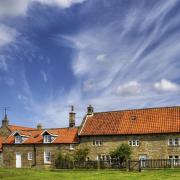This ground-breaking project is restoring nature – and life of all kinds – to a beautiful Nidderdale estate.

To say Roy Burrows had a challenge on his hands is an understatement. The 1,500 acre Summerstone estate had been intensively grazed, the woodland barely touched and wildlife was a rare and precious sight. And it was Roy's job to manage it.
Fortunately the dedicated conservationist had the estate's new owners Steve and Karen Halsall on his side. The trio shared a vision to transform this beautiful corner of Nidderdale, on the edge of the Yorkshire Dales National Park, into an areas teeming with life - of all kinds.
That was three years ago. Since then Roy, with Steve and Karen's trust, has set to work. More than 65,000 trees have been planted, wildflowers have been sown in adundance, hay meadows have been reseeded and valuable heather moorland has been restored. It's not something easily achieved and has taken a great team.
'Steve is very enthusiastic and we have the same goals,' said Roy. 'He sees things in the long term and wants to invest in conservation for the future.

'I'm new to managing a project on this scale, the key is to take expert advice and find good people to work with who share your passion.'
One of those is Roy's wife, Dawn, who helps with all aspects of the estate. The day I visited Summerstone she was replanting new trees that had been blown over with Tom Mann, another full time member of the estate team.
A radical change in the way they deal with livestock has been key to change, as well as the new woodland. Large numbers of sheep had grazed most areas, leaving little habitat for insects or birds. Now water courses and woodland have been fenced off, sheep are kept off the ground at key times of year and a much smaller flock of native Swaledales do a great job of keeping the sward at the right height to attract ground nesting waders including curlew, oyster catcher, redshank and lapwing.
The results were immediate. Endangered lapwings were soon successfully breeding in fields where previously their nests were disturbed or trampled. Roy bolstered efforts by keeping foxes, crows, magpies and jackdaws under control and hopefully away from their eggs and chicks - a crucial part to the conservation effort.

The estate is also establishing a herd of belted Galloways. managed by Steve Ledger, who looks after the farming operation. These rare breed cattle are brilliant at restoring previously intensively grazed areas. They eat the less palatable dominant grasses leaving the tussocky pasture, beloved by waders. Their hoof prints fill with water creating breeding grounds for insects and their cowpats are full of worms which are food for birds in winter - it's a clever trick. The new grazing regime had paid off and provides plenty of long grass for voles, which are the main food source for barn owls.
It's welcome news for self-confessed bird lover, Roy, who approached the Nidderdale Birdwatching Group to supply five barn owl boxes for the estate. The group has since been invited on tours of the estate by the Nidderdale Regional Moorland group of local gamekeepers.
'I'm proud of what we do and we should share our success with others,' said Roy. 'Which is what the bird safaris are about. If you go to other parts of the country without gamekeeping, like the Lake District, Wales or Dartmoor, they've lost all their rare birds due to habitat loss and predators and there's not much to see apart from ravens and crows.'
Not at Summerstone. Roy has installed 50 smaller boxes for birds, three for bats and three for kestrels, all supplied by Nidderdale Birdwatchers and five pairs of redlisted pied flycatchers have taken up residence. As well as full time staff, Roy has engaged consultants to give expert guidance, too. People like Simon Marrington of Tilhill Forestry who has overseen what is one of the largest tree-planting projects of its kind in the UK. Summerstone is essentially "rewilding" a large part of the estate - 54 hectares in fact.

But rather than covering the moorland in trees Simon, in consultation with Roy, designed a plantation plan taking farming and the pheasant shoot into account. Determined to create a natural woodland they have planted in different densities, feathered the edges and used species typical of upland oak woodland - birch, rowan and hazel for ground cover with some conifer and holly to give warmth for the birds and evergreen colour.
There has been plenty of clearing and mending to do. Old fencing has been removed and craftsmen contracted to restore 1,200m of stone walls. Up on the moor, tracks are being repaired, which can be used by walkers and enable access to conserve the moorland plants.
There are currently only 300 acres of heather on 500 acres of moor, the rest being comparatively species-poor grassland and bracken, which Roy has started to clear and reseed with heather, berries and grasses. There is also work being done to restore sphagnum moss and other peat-forming plants.
The network of supporters goes beyond those employed directly by the estate. Local businesses and community play an important part. In the winter, hotels and pubs accommodate visitors coming to shoot, which in turn provides an essential source of income when the tourist season finishes.
As well as the dedication from estate and community, the future of conservation at Summerstone depends on integrating different revenue streams from farming and shooting to tourism. Take one away and it's more difficult to provide jobs and an attractive countryside rich in biodiversity. It will, of course, take time for the estate to break even and long-term financial investment is key.
The good news is there is no doubting Steve and his Karen's commitment to the project. At present, they are considering plans to create accommodation so visitors can stay and enjoy the returning wildlife and restored landscape.
'I am intensely proud of what everyone involved has achieved in a comparatively short time and look forward to making more progress in the coming years,' said Steve. 'It is my and Karen's intention to pass the estate to our boys in a healthier condition at a point where it can sustain itself. Summerstone is a truly special place and we are committed to securing its future.'



























